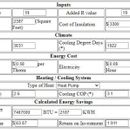Attic Insulation Values
Good Evening, I am in the midst of self building my house just outside of Atlanta (Zone 3A). I have an ICF basement, SIP main floor walls and a truss roof. My plan is to do a unvented roof/conditioned attic with spray foam. 2:12 shed style roof and there will be hvac and water lines in the attic. Last week, I had 3 spray foam contractors come out to give me quotes. I was expecting to need R-39 in the attic, but all three contractors said going to R-39 is a waste of money and R-19 open cell is all that is needed and will pass inspection. I verified with the inspection office that:
“Per the 2015 IECC with 2020 Georgia amendments Section R402.1.6 Trade-Offs are used such as spray foam it can be reduced to no less than R20.”
Originally I scoffed at the idea of skimping out on the attic insulation levels (especially since I’ve gone with ICF/SIPs), but I started playing around with some “Insulation Investment Calculators” and now I’m having second thoughts…
Using the following calculator:
Insulation Investment Calculator (chuck-wright.com)
I’m showing going from R-19 to R-38 will only save $63/year! Am I looking at this correctly? The 2,387 sqft is my roof deck square footage.
I would appreciate any advice!
GBA Detail Library
A collection of one thousand construction details organized by climate and house part










Replies
I don't have a direct response for you, but will chime in with:
1. Are you sure about the $0.08/kwh cost of electricity? If that is GA Power know that may be the stated cost per kwh, but there are all sorts of other costs that are based directly on your usage, plus tax. Usually works out to about $0.17-$0.18/kwh BEFORE they increase the cost with their pending rate case. If the payback is doubled it might make more sense...
2. Be very careful about HVAC in a spray foam attic. There are many reports of coil failure when equipment is installed in a spray foam space. I was skeptical until I experienced it myself and it is a VERY expensive lesson.
3. As I'm sure you know, open cell in a Zone 3A climate can be problematic and cause your decking to rot. Building Science has written about a vapor diffusion vent, which is installed at the ridge. Not sure if you could install one at the top of your shed room, but vapor diffusion should be considered.
Thanks for your response!
1. I just looked at a recent power bill and it worked out to $.10/kwh... so good catch, but didn't move the needle to much. Still showing a payback period of over 40 years.
2. Interesting info about the coil failures... seems to be related to high humidity causing corrosion? So I would think that should be taken care of by the diffusion vent or other mechanical means to keep the humidity in check?
The ROI on insulation much above R20 tends to be pretty long even in cold climates.
In your warm climate, I would look at a flash and batt option with closed cell spray foam. Even about 1.5" to 2" of spray foam provides plenty of condensation control and the cost of the extra R value with batts will be much less. This gets you more R value and without any of the issues of open cell only roof.
If you can bump up your roof slope to 3:12 you can do an unvented roof with batts only and a diffusion vent. A well sealed lower slope assembly should still work but your code official might object. Diffusion vent works the same way on a shed roof, you add in the diffusion area near the peak. You can use the vented roof to wall detail from your metal roofing supplier for the diffusion vent.
Consider finding a way to keep the water and HVAC out of the attic allowing you to cover the much smaller area of the ceiling with much less costly fluffy insulation to a much higher R value.
Walta